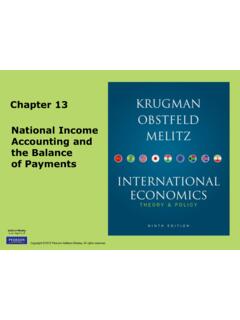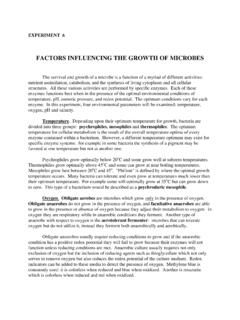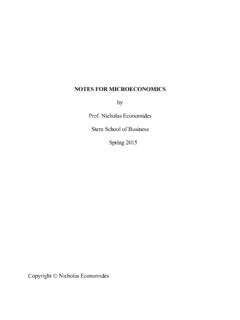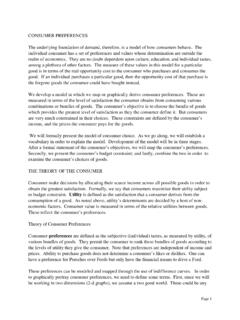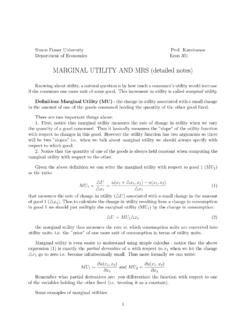Transcription of 20. Homogeneous and Homothetic Functions
1 20. Homogeneous and HomotheticFunctionsHomogeneous and Homothetic Functions are closely related, but areused in different ways in economics. We focus on four main areas,starting with a look at Homogeneity and returns to scale page Homogeneity of derivatives, MRS constant along rays, Euler s the-orem, Wicksteed s Theorem page Ordinal Functions and their equivalence via monotonic transforma-tions, which preserves maxima and minima page Homotheticity and its relation to homogeneity page Homogeneous FunctionsHomogeneity is related to the idea of returns to scale.
2 Let sfocus onconstant returns to scale. A production function exhibitsconstant returnsto scaleif, whenever we increase all inputs in a given proportion, outputchanges by the same equations, letf:Rm+ Rbe a production function. It exhibitsconstant returns to scaleiff(tx) =tf(x)( )for everyx Rm+andt > my use oft >0 rather thant >1 bait and switch? (tx) =tf(x)for allt >1. Thenf(tx) =tf(x)for allt > trivially holds fort= 1. Now suppose 0< t <1. Then 1/t >1, sof(x) =f(t 1tx) =1tf(tx)implyingtf(x) =f(tx) for 0< t <1 Constant returns to scale Functions are also calledhomogeneous ofdegree onebecause we multiplyfbytto the first Homogeneous AND Homothetic Degrees of HomogeneitySimilarly, a function is Homogeneous of degree if we multiplyfbytraised to the power.
3 More formally, Homogeneous +, a real-valued function ishomogeneousof degree iff(tx) =t f(x)for everyx Rm+andt > degree of homogeneity need not be an integer. It can even benegative onRm++.Constant returns to scale Functions are Homogeneous of degree >1, Homogeneous Functions of degree have increasing returnsto scale, and if 0< <1, Homogeneous Functions of degree havedecreasing returns to scale. However, many production Functions withincreasing or decreasing returns to scale are not Homogeneous , such asf(x) =x2+ Cobb-Douglas Production and Returns to ScaleThe Cobb-Douglas production function gives us examples of both in-creasing and decreasing returns to scale.
4 Example : Cobb-Douglas productionfunctions defined onR2+have the formf(x, y) =Ax y withA, , >0. HereAis a productivity (tx, ty) =A(tx) (ty) =t + Ax y =t + f(x, y)showing thatfis Homogeneous of degree + . If + <1,fhas decreasing returns to scale. If + = 1,fhas constant returns to scale. If + >1,fhas increasing returns to can generalize this toRm+. Cobb-Douglas Functions onRm+havethe formf(x) =AmYi=1x iiwith each i>0 andA >0. Such a function is Homogeneous ofdegreePmi=1 ionRm+. Again, it exhibits constant returns to scale whenPi i= 1, increasing returns whenPi i>1, and decreasing returnswhenPi i<1.
5 20. Homogeneous AND Homothetic Examples of Homogeneous FunctionsHomogeneous Functions arise in both consumer s and producer s op-timization problems. The cost, expenditure, and profit Functions arehomogeneous of degree one in prices. Indirect utility is homogeneousof degree zero in price-income pairs. Further, homogeneousproductionand utility Functions are often used in empirical +, the Leontief functionf(x) = minxiis Homogeneous of degree1, as is the linear production functionf(x) =a can easily make increasing or decreasing returns to scalefunctionsby taking their exponentials.
6 Thus the Functions (minixi) and (a x) are Homogeneous of degree elasticity of substitution (CES) function onR2+isf(x) = [ x 1+ (1 )x 2] / for >0 and <1, 6= 0 is Homogeneous of degree . Here = (1 ) 1is theelasticity of More Examples of Homogeneous FunctionsAny monomial,amYi=1x iiis Homogeneous of degree =Pmi=1 ionRm+. A sum of monomials ofdegree is Homogeneous of degree , the sum of monomials of differingdegrees is not examples of Homogeneous Functions include:x3/2+ 3x1/2y, x+y+z, Q(x) =xTAxx8+ 5x4y4+ 10x3y5+ 7xy7+ Homogeneous AND Homothetic Some Inhomogeneous FunctionsThe following Functions are not Homogeneous :sinxyz, x2+y3,3xyz+ 3x2z 3xyxy+yz+xzx+z2,exp(x2+y2).
7 Most quasi-linear utility Functions , such asu(x) =x1+x1/22are nothomogeneous of any degree. The linear term means that they can onlybe Homogeneous of degree one, meaning that the function can only behomogeneous if the non-linear term is also Homogeneous of degree cases thatarehomogeneous of degree one require at leasttwo goods. One example isx1+ (x1x2)1/2which is Homogeneous of degree one onR2+.8 MATH Cones: The Natural Setting for HomogeneityHomogeneous Functions require us to knowf(tx) when we knowf(x).That means thattx domfwheneverx domf.
8 Sets with that prop-erty are called cones. Cones are the natural domain of a vector space. A setC Vis aconeif for everyx Candt >0,tx C. Equivalently,Cis aconeiftC Cfor allt > include the positive orthantRm+, the strictly positive orthantRm++, any vector subspace ofRm, any ray inRmand any set of non-negative linear combinations of a collection of vectors{x1, .. ,xi}. Theset{(x, y) :x, y 0, y x}is an example of the last as it can also bewritten{x=t1(1,0) +t2(1,1) :t1, t2 0}.Cones can also be spiky. The set x R2:x=t(1,2) orx=t(1,1) orx=t(3,1) fort 0 is also a cone, even though it consists of three unrelated rays from theorigin, as in Figure :A spiky cone, made up by the union of three rays through Homogeneous AND Homothetic Homogeneous Functions on ConesWe can redefine homogeneity to apply to Functions defined on a cone in a vector spaceV.
9 A functionf:C Rishomogeneous of degree iff(tx) =t f(x)for everyx Rmandt > the domain of a Homogeneous function so that it isnot allofRm+allows us to expand the notation of Homogeneous Functions tonegative degrees by avoiding division by zero. We can include functionssuch as 1/kxk2, which is Homogeneous of degree 1 on the coneRm++.Restricting the domain also allows us to consider quotientssuch asf(x)/g(x) wherefis Homogeneous of degree 1andgis homogeneousof degree 2, both onRm++. The quotient is Homogeneous of degree 1 2onRm++. To see that, considerf(tx)g(tx)=t 1f(x)t 2g(x)=t 1 2f(x)g(x)which shows the quotient is Homogeneous of degree 1 Properties of Homogeneous FunctionsHomogeneous Functions have some special properties.
10 For example,their derivatives are Homogeneous , the slopes of level setsare constantalong rays through the origin, and you can easily recover theoriginal func-tion from the derivative (Euler s Theorem). The latter has implicationsfor firms Derivatives of Homogeneous FunctionsWhen a function is Homogeneous , its derivative is also Homogeneous ,but with the degree reduced by Rmbe an open cone andf:C RisC1andhomogeneous of degree . Then the derivativeDfis Homogeneous ofdegree( 1). homogeneity,f(tx) =t f(x). Taking thexderivative of thatequation, we obtaint Df(tx) =t Df(x).



